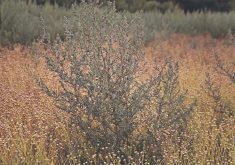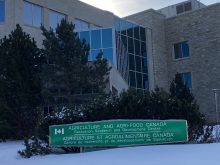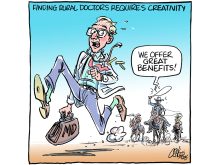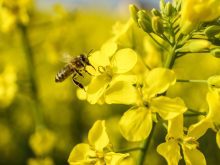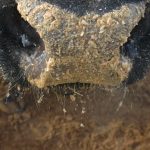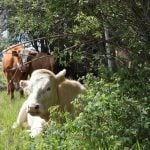The most common congenital anomalies seen in cattle at the Animal Health Centre in British Columbia are cleft palates, limb deformities, umbilical hernias and various heart malformations.
Recently, the centre discovered several calves with another condition called aplasia cutis, or epitheliogenesis imperfecta.
This easy to identify abnormality, though rare, is dramatic because affected calves are born with missing areas of skin. It looks like the skin has been torn away.
Unfortunately, the disease doesn’t end there. Secondary complications usually cause death.
Calves afflicted with aplasia cutis are full term with normal birth weights and body shapes.
Read Also

Kochia has become a significant problem for Prairie farmers
As you travel through southern Saskatchewan and Alberta, particularly in areas challenged by dry growing conditions, the magnitude of the kochia problem is easy to see.
However, they are missing various amounts of epidermis, which is the surface layer of the skin, on their legs, noses, muzzles and tongues.
In most cases, the disease is restricted to the bottom of the legs and the feet, but it can be so severe that the entire body is affected.
Other defects often accompany aplasia cutis. Some calves have shortened lower jaws causing them to resemble a parrot.
Others have occluded ear openings, deformed hoofs or sealed anuses. The latter condition, called atresia ani, causes retention of feces and subsequent abdominal enlargement. In a few of these cases, surgery to open the anus can save the calf’s life.
In the rare case where the skin defects are minor and the calf is otherwise healthy, the wounds may heal over with scar tissue. In most calves, however, the areas of missing skin are too large to scar over.
Because the most important natural barrier to bacteria is missing, calves with aplasia cutis easily contract infections and many die from septicemia, a blood infection.
One of the incidents of aplasia cutis reported by the AHC involved a Simmental calf that was normal except that its skin was missing on the lower parts of all four limbs. In this purebred operation of 200 cows and five bulls, this was only the second time that the defect had appeared in almost 25 years.
Aplasia cutis is recognized as an inherited condition. There had been no recent livestock introductions to this farm, so the genes for the disease were obviously already present in the herd. It was just chance that allowed this autosomal recessive trait to surface.
Many defects in calves are controlled by a recessive mode of inheritance. Under these conditions, the mating of two animals that both carry the defective, recessive gene induce the anomaly. Carrier animals also have a normal gene that dominates the recessive, ensuring that they appear clinically normal. A carrier animal can pass along a normal or a recessive gene to its offspring.
If a calf inherits a normal gene from each parent, it will be clinically and genetically normal. If it receives a normal gene from one parent and a defective gene from the other, it will appear normal, but it will be a genetic carrier, just like its parents.
Only the calf that gets a recessive gene from both parents will show signs of the anomaly, in this case, aplasia cutis.
Aplasia cutis has been reported in such breeds as Holstein, Jersey, Shorthorn, Dutch Black Pied, Swiss Red Pied, German Yellow Pied, Hereford, Ayrshire, Angus, Brown Swiss and Sahiwal. It has also been recognized in crossbred cattle.
Horses, dogs, cats, pigs, and sheep also suffer from the disease.
Like so many other genetic diseases, the appearance of an inherited defect creates a dilemma for producers.
Are the parents of calves with recessive anomalies valuable enough to keep, even though they carry a gene that could be passed on to more of their offspring? There is no blood test available to detect carriers of aplasia cutis, and probably never will be because it is so rare.
It can only be tracked by examining the lineage of affected calves and labelling the parents as carriers.
Jeff Grognet is a veterinarian and writer practising in Qualicum Beach, B.C.




